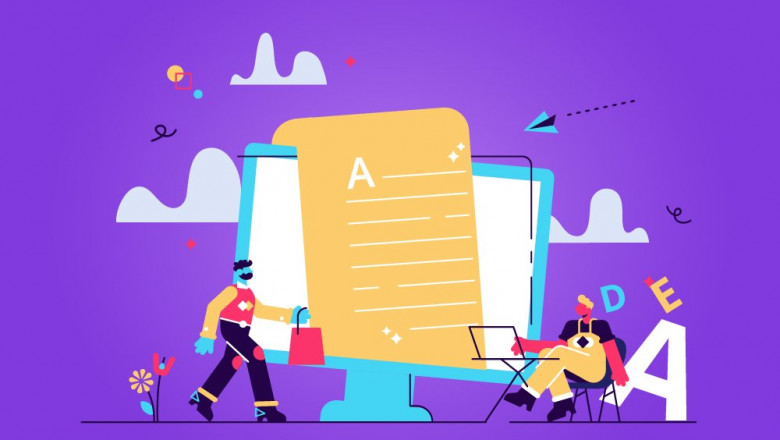views

What is the Buyer Journey Today and How to Incorporate Content Into It?
If you are a marketer, sales professional, an entrepreneur or even a marketing student, you must have heard a lot about the buyer’s journey. We are all told to know our customer’s journey. That journey is important simply because it helps you understand the way a customer is getting attracted to your brand and the path they follow before they finally make a purchase.
This understanding of your buyer shapes your marketing and sales strategy and helps you build the sales funnel which finally converts the customer into a client.
As marketeers we are taught to rely on the traditional sales funnel – the model which was first developed by E. St. Elmo Lewis in 1898.
Here is a simple explanation from Wikipedia which sums it up nicely.
For years the AIDA model was used to explain buyer behaviour. They started at the top of the funnel, moved through the additional layers and then emerged as a new customer. What is important to note here is that in this model, the sales rep has a large part to play. They were responsible for the pushing a passive customer through the “Awareness”, “Interest” and “Desire” stages.
It’s they who decided which technique to use to explain to the buyer what he wants.
So the sales rep has a huge control over the whole process since they get to decide what techniques they will use to create demand in the customer. In this model, the sales rep is the only one who tells the customer about the product, its greatness, its price, its USP.
Also Read: 7 Customer Engagement Strategies That Really Work
That is exactly what has changed now. The customer no longer needs the sales rep to tell her anything. They can get the information, almost a truckload of information, much before they actually hit the shopping place – online or offline. This has created a shift in balance from the sales rep to the customer.
The customer is now in more in control of the whole process, and infact, dominates the whole process. And that is why the sales funnel is no longer a funnel.
Well, the buyer journey is still there. Only that it has become very different and complex than what it was before. And that is because the customer goes through a very different journey today before buying a product.
The thing to note is that – the buying journey is no longer a step-by-step process, a liner journey. It’s much much more messy since consumers are moving back and forth within the various stages, wandering off and then coming back, reading more, comparing, asking friends, discovering new things and then reconsidering those decisions before they make a final purchase. The whole process is much more longer and definitely not linear.
In 2018, a Garner’s research confirmed that the buying definitely did look different today. They explained that the customers had to complete 6 buying jobs to their satisfaction before they did make a purchase.

What can be seen here is that there is no linear pattern to the whole buying journey. Infact, customers move around in loops, taking a decision and then reconsidering that decision again.
You can read more about this here.
What we can surmise from this finding is that the whole process of buying is not sequential but more like a set of simultaneous jobs.
The most definitive piece on what the buyer journey looks today came out last year. It was published by Google in a paper named Decoding Decisions: Making Sense of the Messy Middle.
For some time now, the search engine giant has been saying that buying is no longer a linear journey, from awareness to purchase. Buying has become defined by intent and the customer’s need to know more and more, which has reshaped the funnel.
But there has been nothing definitive like the above paper written by Alistair Rennie and Jonny Protheroe, who work on Google’s consumer insights team in Great Britain.
In a nutshell, this is what they found –

The centre of this model is the messy middle – “a very complex space between triggers and purchase, where customers are won and lost.”
1. THE TWO MENTAL MODES – The messy middle is created when the buyer switches between two stages, or two mental modes. First is the exploration stage, where they are presented with an enormous amount of information and choices. The second is the evaluation stage where they try to cut down on their choices and narrow down on what they want to buy.
2. THE LOOP– This process looks more like a loop where the buyer goes back and forth between the exploration and evaluation stages. It’s what Google calls the “MESSY MIDDLE”, where the customer is flip-flopping between exploring their options and expanding their knowledge by considering other things and then going back to explore more and then evaluating more options.
3. THE ALWAYS-ON EXPOSURE OR AWARENESS STAGE– The exploration or awareness stage where you have become aware of products in a particular category as a result of everything you have heard or read about those products online and offline – is always on. This means, that unlike the original AIDA model, exposure can impact or change your decision-making process at any time. You can become aware of a new product just as you are going to buy something and a result of that, you either abandon that purchase or make that purchase and then swing away from that brand to a new brand.
Now that we know the buyer’s journey is more like a loop, our job as content marketers becomes more straightforward. The faster we get the buyer out of the loop, the faster we mint a new customer.
This means understanding what exactly the buyer is thinking in the messy middle and trying to create content that answers those questions at every stage.
This also means discovering the “Search Intent” at every stage of the buyer journey and creating content types based on that.
For that it is extremely important to understand each stage of the buyer journey. So here we go.
The old buyer’s journey might have changed, and become non-linear and more complex, but the main elements still remain relevant today.
The journey of any buyer will start with a pain point, for which she will try to search for a solution. This will push the consumer to search for brands/products that will give her the solution. Hence she enters the Awareness stage.
The consumer will then develop an interest in a particular solution and start searching for more relevant information, which will drive her to explore the market for different solutions.
Then comes the desire to buy a particular product, moving from liking it to wanting it. So from a total universe of different things, the customer starts narrowing down. The journey towards making a purchase has started.
The consumer has settled for a particular solution and has the intention to buy. From a business point of view, the iron is now hot to strike and make the killing. All you have to do is to spur them into action and make that purchase.
As content marketers, we need to find out what is the search intent of the buyer at every stage of the journey and then try and answer those questions. So let us take every stage one by one.
1. EXPOSURE/AWARENESS STAGE:
As a brand you might want to address these questions –
a) Pain Points and Touchpoints:
How is your category likely to get discovered? What are the typical pain points that a customer experiences before he starts searching about your product. What is the likely purchase trigger?
b) Education:
What questions/terms/keywords are they likely to use when become aware of this problem and start educating themselves?
Content formats to offer at this stage
2. EXPLORATION STAGE
Questions you need to answer
a) Relevant Information
What are the relevant information that you can provide to your buyer at this stage that will convince him to move to the evaluation stage.
b) Trust Factor
Why should the prospect trust your service/product? What data points can you give a consumer who is exploring your products/services?
Content formats to offer at this stage
3) EVALUATION STAGE :
Questions you need to answer
a) What is the best offer?
What is the best offer you can offer him based on the criteria he/she is likely to apply while buying the product?
b) What is the compelling reason to buy?
What compelling reason can you give your buyer to buy your products, something he will not get elsewhere.
c) Expectations:
What can you offer in terms of expectations that he has from buying your service? Are you offering data, social proof?
Content formats to offer at this stage
4) Action/Purchase Stage
Questions you need to answer
a) Have the right call to actions been used?
What is the best CTA you can use to spur the user into action and buy your product?
b) Is the purchase easy to make?
Are you making your touchpoints for sales easy enough to translate into sales? For eg, is your landing page or emailer easily leading the customer to make a purchase?

It’s always important to know that you have offered the right communication at every touchpoint. A great place to begin is to draw up a simple chart where you write down the various customer touchpoints at every stage of the buyer journey and see how best you can improve the content formats. This will help you gain a bird’s eye view of your customer’s journey very easily.
This is important because it will tell you whether your hypothesis about your customer’s journey is right or wrong.
You can start with a basic template like this:

Do not stop this exercise until you can deliver content experiences that speak to your buyer. The intention is to remove all friction from the buyer’s journey and create a seamless process that works for your business. Understanding your buyer’s journey is vital since it should form the core of your digital marketing strategy and planning.
While this mapping can be very intensive, you will definitely feel the impact of this exercise on your business. As a content marketer or a business owner, you must always review your buyer’s journey every once in a year to understand what has changed, and then adapt accordingly.
The buyer journey is crucial for all marketers, since tells you what the customer is looking for. All you need to do as a digital marketer/business owner is know how to solve those queries and nudge the buyer from one stage to the other, finally getting a new customer. Mapping the customer journey is the first thing we do while brainstorming and creating digital marketing plans for our clients. By putting the customer at the heart of whatever you do, we ensure a more sustainable and successful content marketing experience. We hope you can do this too.
If you have any queries, you can always drop us a mail at sales@justwords.in or connect with us on our website here.

Don’t miss the read













